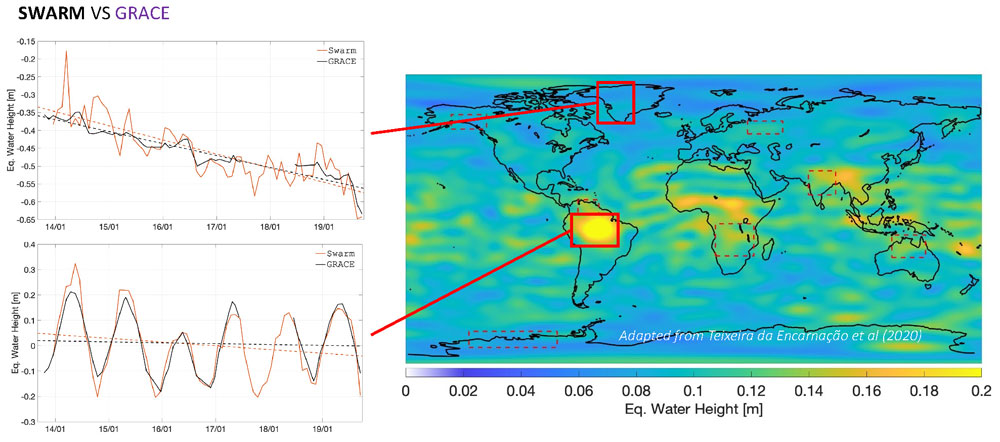- Learn & Discover
- Gravity Field Models from Swar...
Gravity Field Models from Swarm data
29 Apr 2020
In addition to its geomagnetic objectives, GPS receivers onboard Swarm can and have already been exploited to measure temporal variations in Earth's global gravity field. These data are instrumental in alleviating the data gap between the GRACE and GRACE-FO missions to map Earth's mass transports.
Although knowledge of Earth's gravity has improved considerably with the CHAMP, GRACE, and GOCE satellite missions, the geophysical community has identified a need for continued monitoring of the time-variable component with the purpose of estimating hydrological, glaciological, and oceanic seasonal cycles, and their long-term evolutions and trends. Currently, the GRACE-FO satellites launched in May 2018 are the sole dedicated provider of these data, while previously the GRACE mission, which ended in July 2017, fulfilled that role for 15 years.
However, the research team behind the MAGF project (Multi-Approach Gravity Field models) are now able to present high-quality gravity field models from Swarm GPS data that constitute an alternative and independent source of gravimetric data, albeit at a lower spatial resolution. In effect this can alleviate the 10-month or longer data gap between GRACE and GRACE-FO, as well as shorter gaps in the existing monthly time series of the two missions.
The minute variations of Earth's gravity field over time are attributable to mass transports of water and land caused by geophysical processes within the Earth system. These include melting and accumulation of ice reservoirs (mountain glaciers, ice caps, ice-sheets), degradation of Earth's permafrost layers, atmosphere and ocean circulations, surface and groundwater storage changes, precipitations, floods and droughts, land subsidence or uplifts, and seismic events. Swarm's onboard Global Positioning System (GPS) receivers are able to determine the evolutions of the orbital positions of all three satellites with a precision of a few centimetres. Positions are estimated using the so-called kinematic approach, optimally exploiting the geometric information content of the GPS measurements with less dependent on the use of imperfect force models. This approach allows the MAGF team to derive the small temporal variations in Earth's gravity field without prior assumptions about the reference gravity field model.

In an article published in Earth System Science Data, the team demonstrates an agreement of better than 4 cm in terms of Equivalent Water Height over land areas with respects to the GRACE and GRACE-FO models at the 1,500 km spatial scale. A closer agreement between Swarm and GRACE-FO products for spatial scales larger than 1,500 km is achieved after 2016 due to the lower solar activity, which reduces the drag forces acting on the satellites and leads to smaller ionospheric scintillations affecting the GPS measurements. Swarm data are also expected to contribute to the study of the low degree Stokes coefficients including, e.g. Earth's oblateness, which are poorly observed by GRACE-FO.
For further details, see Teixeira Encarnação, J., Visser, P., Arnold, D., Bezdek, A., Doornbos, E., Ellmer, M., Guo, J., van den IJssel, J., Iorfida, E., Jaggi, A., Klokocnik, J., Krauss, S., Mao, X., Mayer-Gurr, T., Meyer, U., Sebera, J., Shum, C. K., Zhang, C., Zhang, Y., and Dahle, C. (2020). "Description of the multi-approach gravity field models from Swarm GPS data", in: Earth System Science Data, DOI: 10.5194/essd-2019-158.
Through Swarm DISC, ESA supports the MAGF team with members from the Astronomical Institute of the Czech Academy of Sciences, Astronomical Institute of the University of Bern, Delft University of Technology, Institute of Geodesy of the Graz University of Technology, and the Division of Geodetic Science, School of Earth Sciences of the Ohio State University. This activity is also conducted in the frame of the Combination Service of Time-variable Gravity Fields (COST-G), under the umbrella of International Association of Geodesy (IAG)'s International Gravity Field Service (IGFS). The models are distributed on a quarterly basis through the Swarm Data Dissemination Server and the International Centre for Global Earth Models (ICGEM).